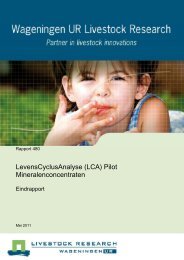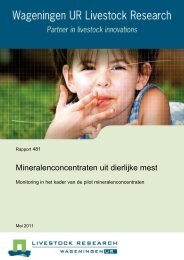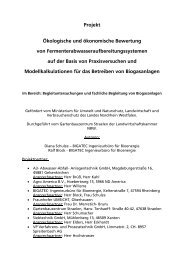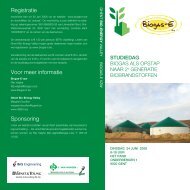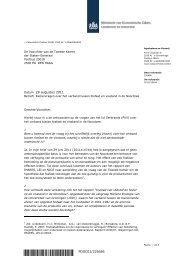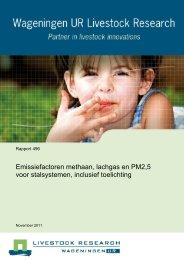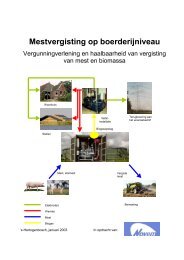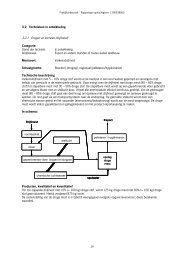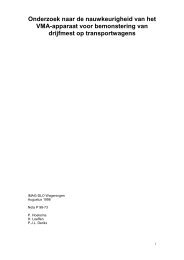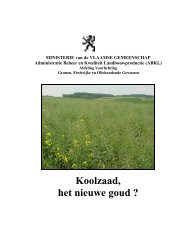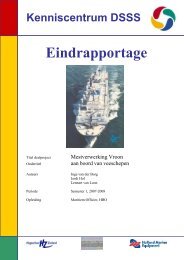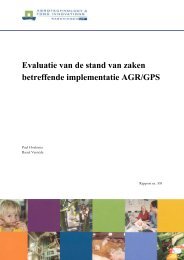Monitoring methane and nitrous oxide reduction by manure treatment
Monitoring methane and nitrous oxide reduction by manure treatment
Monitoring methane and nitrous oxide reduction by manure treatment
Create successful ePaper yourself
Turn your PDF publications into a flip-book with our unique Google optimized e-Paper software.
4.1.4 Solid/liquid separation<br />
Report 627<br />
Manure separation is a process where soluble <strong>and</strong> not soluble particles are separated using a<br />
mechanical separation process, such as filtration or centrifugation. The purpose of the separation<br />
process is to obtain a solid <strong>and</strong> a liquid fraction which (after storage) may be further processed (for<br />
example composting of the solid fraction, production of mineral concentrates from liquid fraction) or<br />
directly applied into the field. Manure separation is applied for both pig <strong>and</strong> cattle <strong>manure</strong>. Manure<br />
separation at pig farms is usually the first step of a continuously performed <strong>treatment</strong> process. This<br />
means that the storage time of the raw pig <strong>manure</strong> is much shorter at farms with <strong>manure</strong> <strong>treatment</strong><br />
(several days) than at farms without <strong>treatment</strong> (several months). Cattle <strong>manure</strong> is usually separated at<br />
the end of the storage period when the liquid fraction can be applied on the field, which means that<br />
<strong>manure</strong> separation at dairy farms has only little effect on the storage time of the raw <strong>manure</strong>.<br />
4.1.5 Production of mineral concentrates<br />
Mineral concentrates are produced in order to reuse nitrogen from animal <strong>manure</strong> as much as<br />
possible within the boundaries of the <strong>manure</strong> legislation. Nitrogen is extracted from livestock slurry in a<br />
multi-step <strong>treatment</strong> process including mechanical separation of the raw slurry into a solid <strong>and</strong> a liquid<br />
fraction, polishing of the liquid fraction <strong>by</strong> removing the remaining suspended solids using<br />
coagulation/flocculation <strong>and</strong> finally concentration of the dissolved minerals <strong>by</strong> reverse osmosis (RO) to<br />
produce a mineral concentrate <strong>and</strong> a permeate, the latter being relatively clean water.<br />
4.1.6 Composting/drying/pelleting<br />
Composting is a process where microorganisms transform degradable organic matter into CO2 <strong>and</strong><br />
water under (normally) aerobic conditions. This process results in an increase of the temperature of<br />
the stored <strong>manure</strong> to values of 50-70 ° C, leading to the evaporation of the produced water <strong>and</strong> the<br />
elimination of existing pathogens in the <strong>manure</strong>. The <strong>manure</strong> is usually stored in an open building,<br />
meaning that the <strong>manure</strong> will be protected against the direct influence of rain <strong>and</strong> sun, <strong>and</strong> still being<br />
in contact with outside air. Manure can either being left during the whole composting process<br />
untreated (passive composting), mechanically turned for a number of times (extensive composting), or<br />
actively aerated (intensive composting), the latter normally occurring in a closed building. Poultry<br />
(solid) <strong>manure</strong> can be directly used for composting. Liquid <strong>manure</strong> from pigs, cattle or poultry cannot<br />
be directly used for composting. By separating <strong>manure</strong> in a liquid <strong>and</strong> solid fraction, the solid fraction<br />
(dry matter of 20-35%) may be further being treated <strong>and</strong> used for composting.<br />
4.2 Emissions<br />
4.2.1 Co-digestion<br />
Treatment<br />
Emissions from an anaerobic digester may occur from storage of substrates, the production reactor,<br />
the biogas engine (heat <strong>and</strong> power unit) <strong>and</strong> storage of digestate. Koop et al. (2011) conclude from a<br />
literature review, that the <strong>methane</strong> slip during conversion in a biogas engine is the main source of<br />
<strong>methane</strong> emissions from anaerobic digestion. The overall emission of <strong>methane</strong> is estimated at 3% of<br />
the total <strong>methane</strong> production. Recent measurements on <strong>methane</strong> emissions from a small biogas<br />
engine (360 kW) in the Netherl<strong>and</strong>s show a <strong>methane</strong> slip of 0.5% (van Dijk, 2012). Anaerobic<br />
digesters process animal waste under anaerobic conditions (anoxic) to produce <strong>methane</strong> gas (biogas),<br />
which can then be used to generate heat <strong>and</strong> electricity as an alternative energy source.<br />
14





